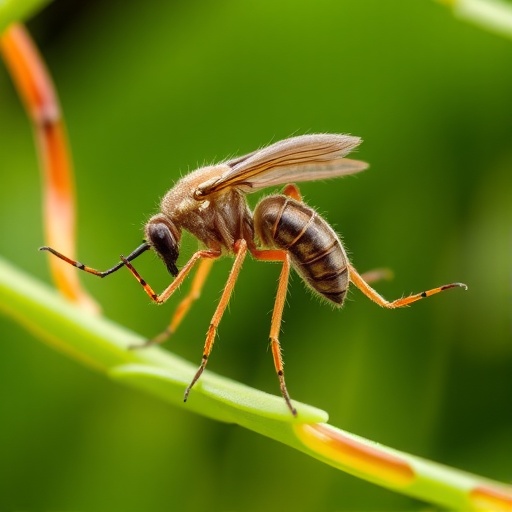In a groundbreaking development poised to shift the paradigms of parasitic disease treatment, a recent study has illuminated the potential of eugenol, a naturally occurring compound, in battling Leishmania major, the causative agent of cutaneous leishmaniasis. This research offers a promising avenue in combating a notoriously stubborn pathogen through both experimental and computational methods, heralding a novel approach grounded in nature-derived bioactive substances.
Leishmaniasis, a neglected tropical disease, continues to impose significant health burdens worldwide, primarily in tropical and subtropical regions. Conventional treatments frequently face challenges such as toxicity, resistance, and high costs. These limitations underscore the urgent need for alternative therapies that are both effective and safe. The investigation into eugenol, a phenolic compound predominantly found in clove oil, represents a strategic pivot towards plant-derived agents that may circumvent the drawbacks of synthetic drugs.
Delving deep into the pharmacodynamics of eugenol, researchers employed in vitro assays to gauge its efficacy against promastigote forms of L. major. These assays provide a controlled environment to observe direct interactions between the compound and the parasite, allowing for precise measurements of inhibitory concentration and cytotoxic effects. Remarkably, eugenol demonstrated significant anti-leishmanial activity, suggesting a potent mechanism of action that merits further scrutiny.
.adsslot_t39P7AETdx{ width:728px !important; height:90px !important; }
@media (max-width:1199px) { .adsslot_t39P7AETdx{ width:468px !important; height:60px !important; } }
@media (max-width:767px) { .adsslot_t39P7AETdx{ width:320px !important; height:50px !important; } }
ADVERTISEMENT
The dual approach of combining wet-lab and in silico analyses reflects a modern trend in drug discovery that accelerates the identification of promising compounds while minimizing resource expenditure. This synergy not only validates eugenol’s candidacy but also establishes a platform for screening other phytochemicals against Leishmania species and potentially other pathogens. The implications of such methodologies extend far beyond this study, sparking enthusiasm across parasitology and medicinal chemistry communities.
From a clinical perspective, the implications are profound. Eugenol’s demonstrated efficacy and presumed lower toxicity compared to conventional antileishmanial drugs could lead to more accessible and tolerable treatment regimens. Moreover, with increasing concerns over drug resistance, introducing compounds like eugenol could reinvigorate treatment protocols and improve patient outcomes, especially in resource-poor settings plagued by leishmaniasis.
Furthermore, understanding the pharmacokinetic properties of eugenol and its bioavailability in human tissues remains a crucial next step. Natural compounds often face hurdles such as poor solubility or rapid metabolism, which can thwart their therapeutic potential. Insights gleaned from molecular docking may guide chemical modifications to enhance these properties, balancing potency with stability and safety.
The broader significance of this research ties into the growing global emphasis on natural product libraries as reservoirs for drug leads. Eugenol, long recognized for its antiseptic and analgesic qualities, now joins a growing list of phytochemicals repurposed for infectious disease management. This paradigm championed by natural product pharmacology not only offers eco-friendly alternatives but also inspires a renaissance in ethnomedicine-inspired drug development.
Intriguingly, the structural elucidation of eugenol’s binding interactions reveals specific amino acid residues involved in the affinity and specificity toward Leishmania proteins. These molecular details could inform future design of eugenol derivatives or analogs with optimized activity profiles. Rational drug design efforts fueled by such data have the potential to produce next-generation antileishmanial agents with enhanced efficacy.
This investigation also contributes to an expanding body of literature highlighting the utility of combining traditional knowledge with cutting-edge technology. Through molecular docking and in vitro validation, the study bridges the gap between historical use of natural remedies and contemporary biomedical sciences. Such interdisciplinary efforts epitomize the future of infectious disease research and therapeutic innovation.
While further studies are needed to translate these promising in vitro results into clinical success, the current findings establish a robust foundation. The incorporation of toxicity assays, pharmacodynamic profiling, and in vivo validations will be essential to move eugenol from the laboratory bench to clinical trials. Collaborative efforts among parasitologists, pharmacologists, and clinicians will be pivotal in realizing the therapeutic potential evidenced herein.
Overall, the investigation into eugenol’s role against Leishmania major epitomizes a fusion of ancient botanical wisdom and modern scientific rigor. Its potent anti-parasitic activity, supported by molecular docking insights, unfolds new horizons in the quest for safe, effective, and affordable treatments. As the scientific community continues to grapple with parasitic diseases, this research may prove to be a beacon guiding future drug discovery pipelines.
In conclusion, the study marks a significant stride in Leishmaniasis research by validating eugenol’s bioactivity through precise laboratory experimentation and computational modeling. The dual confirmation enhances confidence in pursuing eugenol-based therapeutics and showcases the transformative potential of integrating natural products with contemporary drug development techniques. This nuanced approach not only enriches scientific understanding but also reinforces hope for millions at risk from this debilitating disease worldwide.
Subject of Research: Investigation into the in vitro anti-leishmanial activity and molecular docking properties of eugenol against Leishmania major.
Article Title: In Vitro Anti-Leishmanial Activity and Molecular Docking of Eugenol as a Potential Agent Against Leishmania Major.
Article References:
Mohamadi, N., Karimi, S., Sharififar, F. et al. In Vitro Anti-Leishmanial Activity and Molecular Docking of Eugenol as a Potential Agent Against Leishmania Major. Acta Parasit. 70, 147 (2025). https://doi.org/10.1007/s11686-025-01089-w
Image Credits: AI Generated
Tags: alternative therapies for leishmaniasisbioactive substances in disease treatmentchallenges in conventional leishmaniasis therapiesclove oil medicinal propertiescombating neglected tropical diseasescutaneous leishmaniasis researcheugenol anti-leishmanial activityin vitro pharmacodynamicsLeishmania major treatmentnatural compounds in medicinephenolic compounds and parasitesplant-derived therapeutic agents






